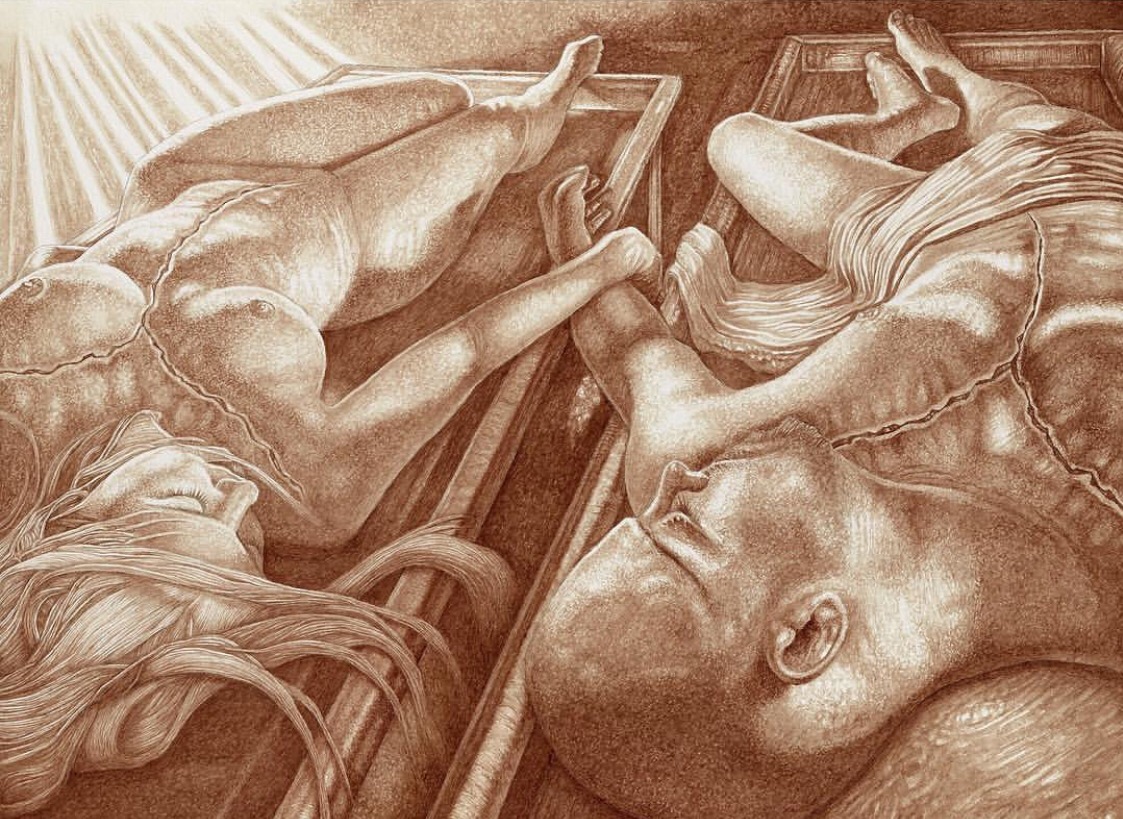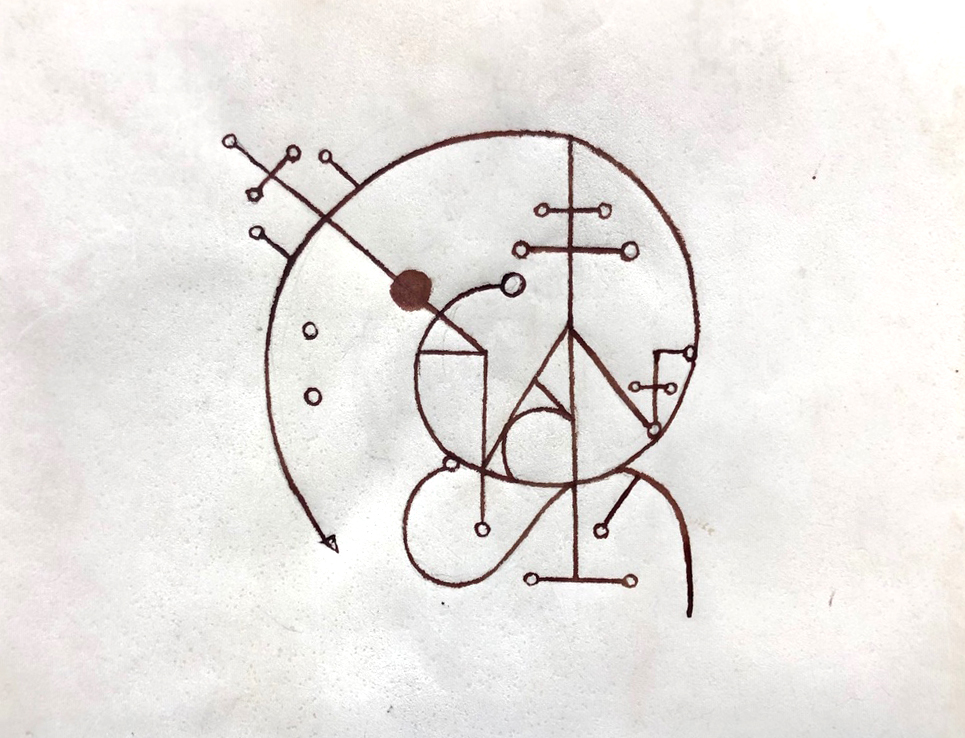If the tortured, decaying human figures depicted in Vincent Castiglia’s paintings aren’t enough to elicit some kind of emotional response, knowing the artist’s preferred medium at one point pumped through his veins just might do the trick.
For the past 20 years, the Brooklyn-born painter and distinguished tattoo artist has made a name for himself in the world of dark, macabre art creating large-scale paintings made in large part with his own blood.
Using a fluid similar to the viscosity of watercolor paint, Castiglia combines his blood—extracted intravenously—with water to create the rusty-colored medium. His illustrations, self-described as “figurative surrealist” are monochromatic sepia-toned tableaus of gaunt, ghostly and disfigured humans, portrayed in varying stages of decomposition. His works utilize a multitude of religious iconography and symbolism—both Christian and Pagan—that have captivated the attention of occult art collectors, listeners of heavy metal music and just about anyone who enjoys gazing at some weird art.
His work has drawn attention from prominent names in the heavy metal music scene, most notably, Slayer guitarist Gary Holt, who commissioned Castiglia in 2016 to paint his guitar using both Holt’s and Castiglia’s blood, the late Gregg Allman was an avid fan of Castiglia’s artwork, and purchased several of his paintings, and comedian Margaret Cho commissioned the artist to paint with her blood mixed into the piece.

Castiglia’s career catapulted into the global spotlight in 2008 after garnering the attention of H.R. Giger, the renowned Swiss artist responsible for the creature designs in the Alien films. Since his solo exhibition at the H.R. Giger Museum in Gruyères, Switzerland—the first-ever invitation of its kind—Castiglia’s art has been showcased in galleries all over the world.
And now, he’s coming to Long Beach.
His latest exhibition, “Autopsy of the Soul” opens Saturday, June 8, at The Dark Art Emporium in the East Village. The collection will feature some 25 of his works—new and retrospective—and will be open to the public through July 6.
“Looking at Vincent’s work is very cathartic,” Jeremy Schott, owner and curator of The Dark Art Emporium, said. “Each piece is a meditation on the cycle of life and death, light and dark, exemplifying that we cannot have one without the other. Through his imagery, we are reminded that while we are only here for a short time, death may not be the end.”
One doesn’t need to have an obsession with the morbid and macabre to appreciate the nuance of Castiglia’s art. His paintings are exceptionally detailed, filled with tiny brushstrokes that create the delicate shades, patterns and depth that make his subjects both ghastly and hauntingly poetic.
“I think people will see that he’s not a gimmick by any means but a modern master,” Schott said. “The anatomical accuracy in his work is reminiscent of Da Vinci with the surrealistic sensibilities of Dali.”

Castiglia began using blood in his art in 2000, shortly before he began working as a tattoo artist. At first his use of blood began as accent colors in his pen and ink work. Over time, his own blood became the medium the artist says he works with exclusively, except for commissioned pieces wherein he may mix the client’s blood with his own.
It took nearly a decade for Castiglia to fine tune his method. He began by extracting small amounts of blood by cutting himself with diabetic lancets and letting the blood into a spoon, painting quickly from there to avoid coagulation. Traces of this crude method can be seen in blood clots found in some of his early works. Today, he collects his blood intravenously, with the help of a registered nurse. Each session she draws 15-18 3ml-sized vials at a time. He keeps the blood, mixed with an anticoagulant, in his refrigerator for later use.
To create around the five consistencies ideal for him to paint with, he then mixes his treated blood with water. The lightest mixtures use just a few drops of blood. The most opaque consistencies he uses for his darks are made up almost entirely of his blood. The darkest passages in his work are also due to the natural decomposition of his blood drying in the open air, which is, in part, why his pieces can take up to several months to complete.
But all this talk of blood begets the question why one would paint with blood in the first place.
In using his blood, Castiglia says he feels a deeper and truer connection to what he creates than with any other medium. His desire to connect with his work in this way stemmed from a need to heal from a childhood situation that was, as he describes in his documentary Bloodlines: The Life and Art of Vincent Castiglia, extraordinarily abusive. His mother, an obsessive-compulsive hoarder, would physically and emotionally abuse him on a daily basis. The psychological effects were catastrophic.
“I remember when the abuse started kind of feeling like a human being, and then it was like whatever I was born as died and I was replaced with something else, something really old and diseased and longing for death,” Castiglia explained in his documentary.
Robbed of his childhood and any semblance of a safe, loving home, the artist developed a death wish he narrowly avoided during decades of intense drug use that extended well into his adult life. Art was and still is the purest and most powerful salve the artist has used throughout his journey to recovery, and his blood played an integral part in that process. It’s what’s kept him alive.
With every drop of blood that left his body used to render his drawings, he channeled that pain, heavy emotion and raw energy into a physical creation he could work through and once completed, release. He’s come a long way since then.
“I feel like I’ve healed a lot of the way. There’s always, I think, going to be a certain amount of damage there, or trauma there I should say,” he explained over the phone. “But it’s gotten 90% better over time and through the work. I actively engage in my own regiment of help. It has been a really healing, therapeutic process and it is still, I would just say not to the degree when it started.”
The entirety of “Autopsy of the Soul” Castiglia says, represents a milestone in terms of his healing. In a small series that is a subset to the exhibition are eight paintings depicting rune-like shapes and symbols with clean, simple linework. These occult symbols, known as sigils in ritual magic, are all, he says, imbued with a personal and universal healing intent.

While Castiglia’s art adorns the black-painted walls of The Dark Art Emporium this month all visitors who choose to gaze at his work are almost surely guaranteed a visceral experience. Whether the reaction be awe or revulsion, there is a reaction.
“I hope people take away the amount of love and sacrifice that Vincent puts into each piece,” Schott added. “Not only is the work physically draining for him. I’m sure it is emotionally draining for him, as well. This is some heavy art. ”
The opening reception takes place on Saturday, June 8 from 7 to 10 p.m. at The Dark Art Emporium; 256 Elm Ave. Click here for more info.

